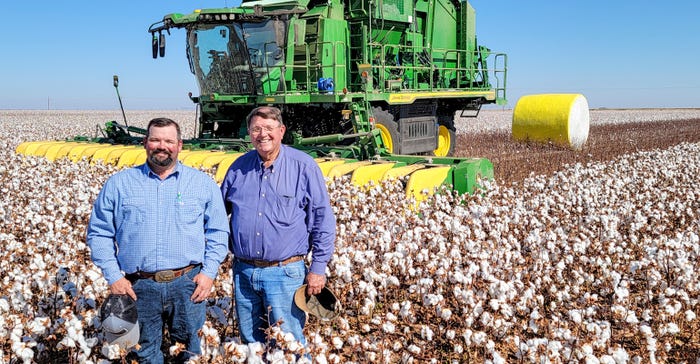
Floydada, Texas, cotton producer Eddie Smith compares driving a John Deere stripper-baler to the days in the early 70s when he returned from college to farm fulltime.
"When I'd harvest, I had a two-row stripper and cotton trailers. When a crop was green and early, you'd go out on a Sunday afternoon by yourself and strip and dump and you didn't have to put up with anybody. So, running these brings me back to that," Smith says. "Now, one man can go out there and basically do the harvest himself. Of course, you have to have somebody to help you load the wrap, but it just really minimizes the labor force to harvest a cotton crop."
Smith farms with his son Eric near Floydada, Texas. They grow wheat and run cattle and for the last 11 years, they've been working with John Deere to develop the stripper baler.
See, 2021 crop: A breath of fresh air
"I started working with John Deere back in 2010, when I was chairman of National Cotton Council," Eddie recalls. "I was at the Beltwide Cotton Conferences and they (John Deere) had just come out with a baler on the picker. So, at the conference, I went to the John Deere booth and asked if they'd ever thought of putting a baler on a stripper. They said, well, not really. It took me two days over the three-day conference of going and visiting with them. We finally got them to agree to meet. They thought it would just be me, but I had a group of growers who got with them on it. We had a good conversation about the feasibilities and whether it would work on a stripper because it's a different kind of cotton than a picker cotton."
The next year, Eddie says John Deere released what they called the concept machine. "It was a picker that had been converted to a stripper and they put a cleaner on it. It was very elementary. The next year, they came out with a prototype."
Eddie would receive one of their two CS690 prototypes to "try out" in his fields and since then, he says his relationship with John Deere has continued to evolve.
"We kept our basket machine for two or three years, just because we were still working with the prototype. We didn't want to rely upon just the baler when we first started. Now, we're 100% baler."
Farm Press visited with Eddie and Eric and rode a round with farm foreman Clint Bigham as he harvested a drip-irrigated field with the new CS770. Below, hear more about what Eddie had to say about the stripper baler and how it compares to the 690 model. Comments from Eric and Bingham are included in the accompanying photo gallery.
What do you like about the CS770 compared to the 690 model?
"Nice cab but also it has a greater cleaning capacity. It has 74 inches of cleaning capacity compared to 60 inches on the 690, so you get a better turnout. And with that better turnout, it cuts your ginning costs down. Plus, we're seeing a higher density module, so you get more weight in the module. The 690 will weigh the modules just like this machine will but you actually know the weight and moisture level in the cotton as you harvest it. We're seeing higher weights, which cuts down your cost of wrap because you're getting more linen, cotton inside the wrapped module. Driving down the highway, it looks the same but it's more dense and heavier, so you cut the cost of the wrap to some extent.
See, John Deere brings two new cotton harvesters to market
Can you run faster with the CS770?
"This machine is a 12-row compared to an eight-row. If you're in heavy cotton, you're probably going to get 18% to 30% more production than you would with the just a standard eight-row. In dryland production, usually speed is not an issue because you can't load the machine. So, you'll get another 50% of capacity because you can harvest at the same speed as an eight-row but you're stripping four extra rows, so your efficiency goes up.
The CS770 is the next step in the evolution of the cotton harvester for stripper cotton because it has a different engine and a completely different frame, baler and wrap floor. There's a lot of technical things. It's a different machine than the 690. We ran the 690 and 770 side-by-side all day one day in the same field. The next day I filled up with diesel and I put 30 less gallons of fuel in the 12-row than the eight-row and that got my attention big time. So, that's a big savings on a daily basis when you run a lot of days a year."
What else catches your attention about the new series?
"The cost of the machine, of course, gets everybody's attention. And when you step out to the 12-row header, then your cost is just nearly double what it is for an eight-row header. So, those are two things that catch you really fast. The reason we feel like we can step up to the 12-row is because with the eight-row we were pushed to the limit. We really had to run long, hard days to get across the crop. A 12-row is going to give us more efficiency, a timelier harvest. The efficiencies that come with the 770 are worth the extra money."
What is your opinion of the folding row units?
"That is awesome. When they first came out it, John Deere wanted us to run the 12-row and I told them, I didn't think it would work because we were at the limit of the capacity of the cleaner. So, they brought it out and it was a 12-row rigid header. You have a challenge with 12-row equipment anywhere you operate and going down county roads. The first thing we told them is we need to have some way of folding it. The next year, they developed a folding header. You're as wide as an eight-row so you're very efficient about moving it anywhere. It's very easy to handle as far as the way it manipulates and is operated from the cab."
See, John Deere’s CP770: Improved speed, safety and comfort
Tell me about the safety features.
"The safety equipment is very efficient. It's easy to use those safety systems where they protect the operator from potential hazards that are with a machine like this. The platform is superb in that respect. Being able to get back to the baler on the platform and also the telepads that are now on the platform make it easier to transform it down."
Any other differences between the CS770 and CS690?
This machine has what they call a closed-hydraulic system whereas the 690 is an open-hydraulic system. There are some efficiencies you get from a closed-hydraulic system that you don't have with an open system. But we're still trying to learn that. We run off cleaner speeds. The cleaner speeds and the cross auger speeds tell you how fast you can go through the field because if you overload them, they're going to choke up on you. So, we're very careful and watch those very closely. The technology and the software continues to evolve, and you can do software updates through the satellite system, so there's constant software updates as John Deere continues to develop different efficiencies for the machine.
About the Author(s)
You May Also Like






